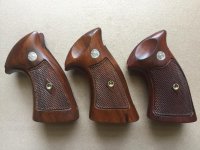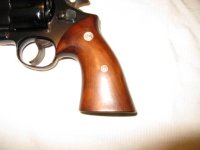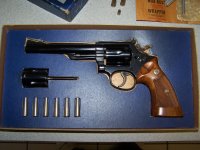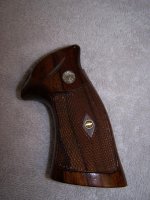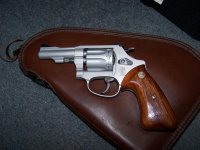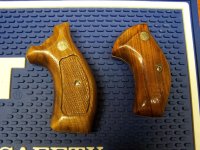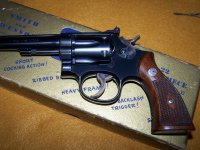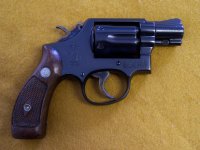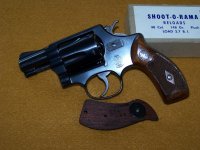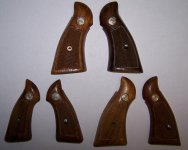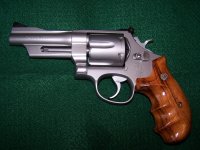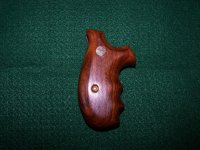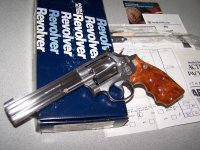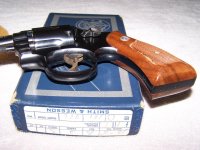I like many S&W enthusiasts began accumulating wood stocks made of various wood types, grains, color, age, configuration, etc. I then decided I wanted an example of each kind of standard issue N-Frame stocks that would have been supplied on the 1st Model .44 Hand Ejector to the Performance Center revolvers of the 1990s. Although I’m still missing a few sets, I have put together an illustrated timeline of N-frame Stocks to hopefully assist in identifying the type/style, date, and material of factory stocks. While this thread is focused on N-frame stocks, most of the information and general time-frames are applicable to K-frame stocks as well. Additionally, I have included a few sections on related topics commonly discussed. Please remember, this is not an exact science and I attempted to utilize commonly accepted date ranges supported by available materials. The rule of thumb is that stocks were used until inventory was exhausted and overlaps or anomalies occur. Lastly, Smith & Wesson publicly advertised “stocks” for many decades and I generally refer to my prewar examples as stocks and more modern examples as grips.
P.S. I’m still learning so please excuse my errors and politely comment below or PM me with suggestions or evidence/documentation to assist with this thread.
A big thank you to Bill (Doc44) for his assistance with some factory directives and information as well as his many stock-related threads over the years.
General Timeline for Introduction of Standard Factory Issued Stocks/Grips:
Non-Target Stocks identified as Service Stocks and later Magna Stocks
1907 – 1911: Checkered Diamond Service Stocks; concaved/dished at top; No Medallion
1911 – 1920: Checkered Diamond Service Stocks; Recessed Large Gold plated Brass Medallions added
1917 – 1919: Smooth Service Stocks; no checkering; no medallion (These stocks were used on Model of 1917 Army revolvers and early model 1917 revolvers had concave “thumbprint” stocks)
1919 – 1930: Checkered Diamond Service Stocks; Non Medallion
1929 – 1938: Checkered Diamond Service Stocks; Large Silver Medallion (*First Style of Stocks to have the serial number stamped on the inside of the right panel). Could be ordered and used with factory grip-adaptor.
1935 – 1946: Checkered Diamond Magna Stocks; Large Silver Medallion; Wood extends higher at the top covering part of the frame in what some refer to as the "horn". Introduction of metal stock circle insert or “washer” on inside of panel to secure medallion (Used up supply into early post-war years.) Directive issued September 5, 1935 that Magna Stocks be used on all Registered Magnums. Directive issued February 2, 1936 that Magna Stocks be supplied on .44, .45, and 38/44 N Frame Models.
1946 – 1967: Checkered Diamond Magnas; Black-Oxide Metal Washer; Small silver medallion becomes standard. *Early Diamond Magnas had a noticeable defined edge at the horn sometimes called “high or sharp shoulder” often <100,000 Serial # (left side in photo). In contrast later examples have a more subtle curve/ridge through the middle of the horn (right side in photo).
January 11, 1966: Directive to remove the diamond center when checkering Magna Stocks
1968 – 1970s: Checkered Magnas, non-diamond (*1971 approximately blued metal washer replaced with bare metal washer on inside)
Target Stocks:
1952 – 1958: Checkered Diamond; Non-relieved left panel; Black-Oxide Metal Stock Circle standard; often found in Walnut; *Examples of “oversize” prototype Target Stocks known as early as Nov. 1951; examples shipped into late 50’s or until inventory exhausted
1956 – 1968: Checkered Diamond; Enlarged Checkered Space and slight palm swell (loosely resembling curves of a Coke bottle…nick named by collectors “Cokes”) Available on .44 Magnum Revolvers and .41 Magnum revolvers. Commonly found in more exotic wood such as Goncalo Alves (Rosewood Very Rare). Shipped concurrently with the other Diamond Target Stocks above.
1958 – 1968: Checkered Diamond; Relieved cutout the shape of a “football” is recessed into the left panel at the horn and becomes standard. Primarily made of Walnut
December 28, 1967: Directive to remove the diamond center when checkering Target Stocks
1968 – 1983: Checkered; Relieved football cutout (1971 approximately black washer replaced with metal “silver” washer on inside of grips) Goncalo Alves most commonly used wood
1983 – 1991: Checkered, Speed loader cutout (relieved “football” cutout is now fully removed); in 1985-86 the washers are removed
Combat Grips
1982 – 1990s: Smooth with Finger Grooves shaped into the front strap. Found on both Round Butt and Square Butt frame configurations (*commonly seen models 24, 624, 629 and Lew Horton variants)
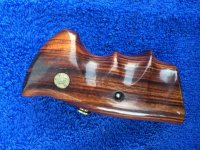
Mid ‘90s – 2000s: The wood and shape of combats change (Often found on Performance Center Models)
1990 into 2000s: Many third party grips are used with Hogue rubber grips being quite common on N-frames as well as other wood, laminate, rubber grips from makers such as Ahrends, Altamont, and Eagle to name a few.
Plain, Smooth, “Presentation” Stocks:
Smith & Wesson offered smooth (non-checkered, non-diamond) stocks with the same shape, washers, and escutcheons relative to the timeframes of the Stocks outlined above. They can be found in the Service, Magna, and Target configurations. Smooth Stocks became more prevalent in the post-war era and are most commonly found in the Target configuration. Smooth Stocks are often called “presentation” stocks as many special order, commemorative, engraved guns can be found in this configuration. As a result, many smooth grips are also found in more scarce or exotic wood offerings ranging from standard Walnut to Goncalo Alves, Cocobolo, Rosewood, Maple, Birdseye Maple, etc.
I like stocks...
Types of Wood/Material:
Pre-War Stocks are generally found in American Walnut and Circassian Walnut
Post-war Stocks are generally made of Walnut or Goncalo Alves. Magnas were made of Walnut and early Targets were made of Walnut. Goncalo Alves was introduced in the mid-1950s and became the standard choice by the 1960s through the 1980s. This is commonly associated with the introduction of many new models in the mid 1950s – 1960s in which more exotic wood choices were used on certain models. These woods include Goncalo Alves, Rosewood, and Cocobolo which became common on checkered and smooth stocks in the 1960 – 1980s.
Special Order or Scarce Materials: Maple, Cherry, Birdseye Maple, Pearl, Ivory, Stag
Rare Configurations/Materials:
Nearly anything you wanted, “never say never” applies when discussing Smith & Wesson.
Pearl, Ivory, Stag/Bone, Engraved and Inlaid stocks all known to exist
Prewar Service Stocks, non-medallion, non-checkered, diamond center (1920s)
Tuskoid – Faux Ivory Diamond Magna Stocks 1930s (.357 Magnum) Estimated < 10 made, *1 in black reportedly
.357 Magnum with "Tuskoid" Stocks...pics added
Roper Stocks could be factory ordered with .357 Magnums (Rare)
Non-Relieved, Diamond, Large Checkering – Coke style Target Stocks
Non-Relieved, Checkered, Non-Diamond Target Stocks dating from 1969-1974 (Courtesy Doc44) 1 know
Fancy Stocks
A slight thread deviation as these aren't Factory Stocks... but here's a set of Ropers in Birdseye Maple. These are unique in shape in that they are best described as short Target Stocks have no horn, and they are wider in the palm than others and appear to have a "built-in" grip adaptor :
Serial Numbers
The serial number of the revolver would be placed on the inside of the right stock panel. A general rule of thumb is stocks pre-1930 have the serial number written in pencil located towards the top and rear edge of the panel. In the 1930s serial numbers were then stamped under the stock circle/washer. This practice carried through into the post-war stocks. At some point perhaps in the mid-1960s the stamped serial number was relocated to the bottom of the right panel.
Any idea on the age or earliest serial number of stamped serial numbers, est. 35,000-38,000 serial range?
Escutcheons
The escutcheon and escutcheon nut were flush with the wood surface until 12-28-1967 to remove the diamond center on stocks. With the removal of the diamond center the escutcheons are recessed thereafter.
Metal Stock Circles “Washers”
Starting with the Pre-war Magnas the medallions would be fastened by a stock circle or commonly referred to as a “washer” found on the inside of the grip panels. These early washers were steel/metal in color and generally had Patent date information on them, although examples without patent dates have been observed.
Post-war washers were metal finished in Black-Oxide and found on stocks into the early 1970s (Approx. ’73-74). In the early 1970s the washers were changed to plain metal washers, silver in color. At some point around 1985 washers were removed.
Accessories - Part Orders
Stocks were available for purchase from Smith & Wesson as an accessory parts order. Each panel (right-hand and left-hand) was given a part number: The left-hand part number was LH5913 or 5826 and the right-hand part number was RH5912 or RH5828.
It appears that in the 1960s – 70s Target stocks were often stamped with the corresponding part number and marked “NT-430” on the inside of the stocks. The “NT” designated N-frame Target stocks and “430” indicated the bore/caliber of revolver. Although, it appears most Target stocks from the late 60s and early 70s were stamped NT430 regardless of what model they were put on. I have seen “NT-38” and “NT-357”. This same terminology can also be found in some literature to differentiate between revolvers made by Smith & Wesson. Per previous posts on the forum: “these designations were used internally by the factory and are descriptive of the revolver being made. NT-430 is the 44 Magnum or Model 29, NT-357 is the .357 Magnum or Model 27. The Highway Patrolman (Model 28) is NTM-38. The Model 58 is N-410. The Model 66 (stainless version of the Combat Magnum) is FT-357. Some of the early parts sheets had the model name and number on them, but this was prior to the introduction of model numbers. –Doc44.”
In some instances the wood type was stamped on the inside (WAL). For example a set of “NT-WAL” stocks would be for an N-frame Target made of Walnut.
Related Topics / Observations:
Shape and Size of early NR Diamond Targets
After handling multiple sets of NR Diamond Targets it is apparent that their shape and size may have been slightly enlarged compared to early examples. As the photos show, the base is shorter in length and more oval in shape. The smaller variant is 2.24” in length at the base compared to 2.44”. Additionally, they are slightly shorter in height which is most clearly shown by the difference in the heel which measure 0.41” versus 0.58”.
Early Non-Relieved “NR” Target Stocks and Serial Numbering
Approximately 1953-‘54, Smith & Wesson began offering Target Stocks as a special order feature or accessory to accompany their many adjustable sight revolvers such as the 1950 Target Model, 38/44 Outdoorsman and .357 Magnum. This was an interesting time period for not only the development of revolvers but the stocks themselves. Many people have debated whether or not early Target Stocks were serial numbered to guns as well as the rarity of serial numbered versus non-serial numbered Non-relieved (NR) Target Stocks. I hope to shed some light on this…
First, lets begin with serial numbering and why early Target Stocks may not be serial numbered. During this time frame Magna Stocks were the standard issue and therefore serial-numbered to the revolver being shipped. An individual could also order Target Stocks as an accessory item to their order, and in this case it appears that the revolvers would be shipped with the Magnas serial numbered to the gun and the Targets were included but un-marked. Meanwhile in some examples revolvers could be explicitly ordered with Target Stocks and the revolver would have shipped with only the Target Stocks attached. In theory the Stocks would have been serial numbered to the gun but it is commonly accepted for them to be non-marked. Lastly, an individual could simply order Target Stocks as an accessory item (parts order) and have the stocks shipped directly to them. Due to the special order nature of Target stocks being supplied while Magna Stocks were standard issue, it is rare to have a revolver with matching serial numbered NR Target Stocks. In review, it appears that only special ordered guns explicitly requesting Target Stocks may have been serial-numbered to the revolver.
In contrast to the prior paragraph there appears to be a group of serial-numbered NR Diamond Checkered Target Stocks that were used from approximately 1955-1958 on Model of 1950/1955 .45 Target Revolvers. Approximately March 1955 the Model of 1955 Target Revolver became the first N-frame revolver to have all Target configurations (Target Stocks, Hammer, Trigger) standard and were supplied with NR Diamond Checkered Target Stocks that were serial numbered to the gun. However, later that year with the approaching introduction of the .44 Magnum and the Combat Magnum a decision was made to relieve the top of the left grip panel to aid in loading/extraction of cartridges. Furthermore, the introduction of these new models resulted in the decision to provide them with Target Stocks made of Goncalo Alves instead of Walnut. As a result existing NR Target Stocks in inventory were not to be used on the new .44 Magnum. To make things more interesting, it appears some NR Diamond Target Stocks had already been serial numbered to existing frames to be used for Model 1955 Targets but these frames were instead used in the .44 Magnum production. These Target Stocks and .44 Magnums were in the 130,XXX serial range. Since nothing was thrown away, it is believed that these serial numbered NR Diamond Targets were subsequently shipped with the Model 1950/1955 revolvers in the 143,000+ serial range until the miss-matched supply was exhausted. As such, I believe there were a number of Target Stocks supplied with serial numbers non-matching to the gun they shipped with due to the .44 Magnum Target Stock switch. (*As a collector of .45 caliber models from this time period, I believe this to be yet another S&W anomaly and not necessarily a “red-flag” when assessing .45 model revolvers with miss-matched stocks.)
Additionally, it is unclear what serial number or when serial numbering of Target Stocks stopped although I can confirm NR Diamond Targets with serial numbers of at least 165,000+ serial number range. I estimate that Target Stocks from 1955-1957 account for the bulk of serial numbered Target Stocks. Outside of this time-frame it would be considered rare for Target Stocks to have a serial number. “Coke” bottle Targets supplied on the .44 Magnum were not serial numbered. Relieved Diamond Target Stocks (Walnut) begin to appear around 1957-58 and were not serial numbered.




























